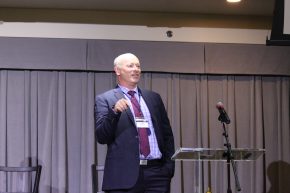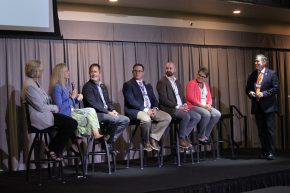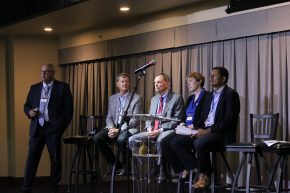
“NOW” panels explore four aspects of nuclear industry and implications for region
 By Tom Ballard, Chief Alliance Officer, PYA
By Tom Ballard, Chief Alliance Officer, PYA
“It’s an amazing time to live in nuclear energy,” said Jon Carmack, Senior Technical Advisor to the Office of Nuclear Energy at the U.S. Department of Energy, in his opening keynote address at Tuesday’s “Nuclear Opportunities Workshop” organized by the East Tennessee Economic Council (ETEC). “Perhaps it’s the first time ever that there has been emphasis on energy security and clean energy at the same time.”

Judging by the turnout – a record of more than 200 people at the all-day program, interest in nuclear power is clearly a “top of mind” item for many in a region with a long and well-known legacy in the nuclear sector as well as a strong footprint in the future in areas like advanced reactor technologies, next-gen reactor designs, and fusion power.
Eric Abelquist, a past Chair of ETEC, perhaps captured the opportunities for the region best in a late December 2021 presentation where he noted significant activities on top of the presence of Oak Ridge National Laboratory (ORNL), Y-12 National Security Complex, Tennessee Valley Authority (TVA), and the University of Tennessee, Knoxville’s (UTK) nuclear engineering graduate program that is tied for seventh place nationally and sixth among public universities in the latest rankings from U.S. News and World Report. Albequist’s listing included:
- Centrus Energy Corp which is working on bringing TRISO nuclear fuel using high-assay low enriched uranium (HALEU) to market in partnership with X-energy;
- Kairos Power which is building the Hermes fluoride-salt cooled test reactor at the East Tennessee Technology Park that is also using TRISO fuel;
- General Fusion that is opening its U.S. headquarters in Oak Ridge; and
- TVA and UTK’s Department of Nuclear Engineering that are partnering on next-gen nuclear energy technologies, including SMRs (small modular reactors).
Each of those efforts was spotlighted in one way or another during the Tuesday sessions that focused on four critical aspects of the nuclear sector: advanced reactors, nuclear fuels, radioisotopes, and the nuclear workforce needs. We attended most of the event but left mid-morning for a lunch meeting, so we missed the discussion about fuels and the first afternoon topic.
As we reflected on the discussions, several points really captured both the challenges and the opportunities for a region with the long history in the nuclear area that East Tennessee has. Those points included workforce needs and today’s challenges of meeting the isotope demand in light of the current Russia-Ukraine crisis and the world’s reliance on Russia as a source for 40 isotopes.
The two panels were as follows:
- Workforce: Moderated by Wes Hines, Professor and Head of UTK’s Department of Nuclear Engineering, the panel included: (1) Meshelle Augustin, Senior Human Resources Business Partner, Nuclear Human Resources & Communications, TVA; (2) Tommy Morgan, Chief Engineer, United Cleanup Oak Ridge (UCOR); (3) Ashley Stowe, Director, Oak Ridge Enhanced Technology and Training Center, Y-12; (4) Ken Tobin, Vice President and Chief Research Officer, Research and University Partnerships Office, Oak Ridge Associated Universities; (5) Joan Bienvenue, Executive Director of the new UT-Oak Ridge Innovation Institute; and (6) Teresa Duncan, Vice President of Workforce and Community Development, Roane State Community College (RSCC).
- Isotopes: Moderated by Lloyd Jollay, Manager Nuclear Material Applications at the Y-12, the panel included: (1) Balendra Sutharshan, ORNL’s Associate Lab Director for Isotope Science and Engineering; (2) James Harvey, Senior Vice President and Chief Science Officer at NorthStar Medical Radioisotopes; (3) Tracy Radel, Vice President of Engineering at SHINE Medical Technologies; and (4) Terry Grimm, Founder, Chief Executive Officer and Senior Scientist at Niowave Inc.

On the workforce front, almost every panelist uttered some version of this phrase: “We are hiring,” and that should have been music to the ears of the college students or recent graduates who were allowed to register for free and network with other attendees.
Just how serious the workforce challenge has become was brought clearly into focus when Stowe told attendees, “We need to hire 2,300 employees next year. It’s a staggering challenge.” For context purposes, the current workforce at the National Security Complex totals 7,700.
Stowe cited the recently announced partnership with UTK and ongoing work with both Oak Ridge Associated Universities and Roane State Community College (RSCC) as resources that Y-12 is accessing to help meet the challenge. One of his fellow panelists was Duncan who offered this advice: “We have to do a better job together,” emphasizing the importance of partnerships and other mechanisms that “engage with the workforce of the future.”
Saying that “our goal is to become that home for talent” in the region, Bienvenue, described several of the workforce-related initiatives her organization is supporting. They include: (1) the SMaRT (Student Mentoring and Research Training) program that involved 43 undergraduates students from around the country in the most recent cohort; (2) an accelerated degree program in cybersecurity in collaboration with UT at Chattanooga; and (3) the new America’s Cutting Edge (ACE) program that is a joint U.S. Department of Defense (DoD) and U.S. Department of Energy initiative launched in 2020 to reestablish American leadership in the machine tool industry. Hines reminded attendees of this important point: “If we don’t know your needs, we can’t help you.”

The other panel that attracted our attention focused on radioisotopes, where Sutharshan described Oak Ridge as “the center of the universe” in that regard. Noting that ORNL supplies 285 of the 315 DOE-supplied (Department of Energy) isotopes, he added that Russia is the other primary source for the world, and the Russian-Ukraine war has placed great stress on the supply chain.
“We have much to do to reduce our reliance on foreign sources,” Sutharshan said, adding that his vision is for this region to become the nation’s leader in radiopharmaceutical therapy R&D. He was on a panel that also included three individuals with private companies. Two of those enterprises were based in Wisconsin, and the third called Michigan home.
“The Upper Midwest is becoming a hub for medical radioisotope production in the U.S.,” said Harvey. His company is a producer of the diagnostic imaging radioisotope Mo-99 that is used to generate Tc-99m that in turn is used in diagnostic imaging to assess the extent and severity of heart disease and cancer. Radel, another of the isotope panelists, described a facility her company is building in Janesville, WI that will be able to produce one-half of the U.S. demand for Mo-99. There’s also a similar facility planned for the Netherlands.
The final panelist was Grimm who spun Niowave out of Michigan State University. He said the company is focused on isotope production for therapeutic purposes that uses a superconducting electron beam accelerator, not a reactor. Noting the importance of getting isotopes to those needing them quickly, Grimm concluded his remarks by teasing a possibility for the region with this question: “Where is the second facility (we will build) in the next few years?”
That should have been music to the ears of those who want to grow the region’s economy on its nuclear history.
Like what you've read?
Forward to a friend!

